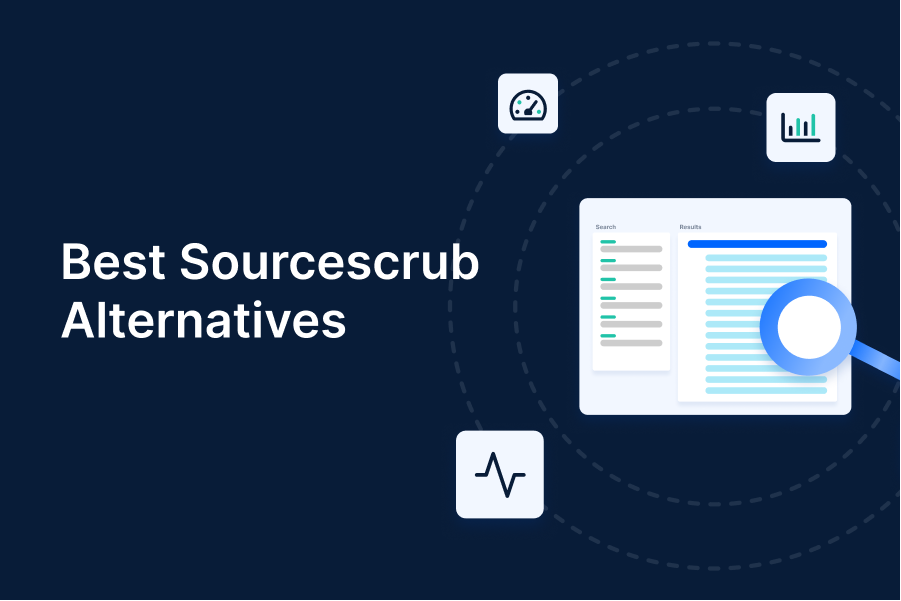Key Takeaways
- Approach matters: Some platforms lean on manual list processing and verification; others emphasize AI-driven search and continuous enrichment. Better AI capabilities often offer faster, broader discovery.
- Coverage vs. depth: Global, multilingual coverage helps avoid blind spots in cross-border sourcing, while profile depth (ownership, financial indicators, decision-makers) reduces tool-switching and supports faster outreach.
- Search experience: Natural-language queries, negative keywords, and “find similar companies” functions speed up shortlisting compared with rigid filters alone.
- Team workflows: Shared lists, notes, alerts, and CRM-ready exports help move from discovery to outreach.
- What users highlight: Ease of use and time savings come up frequently in user preferences and reviews; reported gains range from faster list creation to fewer manual checks before outreach.
Why Firms Look for Sourcescrub Alternatives
Sourcescrub can help deal teams identify and organize private companies by combining web data with human verification. While it enables research, this model can be labor-intensive and slower to scale. As deal sourcing becomes more global and time-sensitive, teams are now prioritizing tools that automate enrichment and provide broader visibility across regions.
The recent integration of Sourcescrub and Grata under Datasite has also prompted some firms to reassess their sourcing stack – comparing platform alternatives on features and aspects such as coverage, search precision, ease of use, and dataset size.
Reasons teams might reconsider include:
- Wanting simpler workflows: Moving from manual list enrichment and updates to more intelligent options.
- Seeking better automation: Smarter alternatives offer features such as natural-language search, intent-to-sell signals, and AI enrichment.
- Needing more scope: Accessing more attractive targets, greater global coverage, and better regional filtering.
Sourcescrub alternatives can address these gaps by automating data collection and enrichment, better interpreting company context to improve search results, and keeping profiles continuously updated – reducing manual work while also improving accuracy and global reach.
What Are the Top Sourcescrub Alternatives for Deal Sourcing?
Platforms used for deal sourcing vary in purpose. Some focus on financial analysis, while others specialize in intelligent discovery and automation.
The best Sourcescrub alternatives for deal sourcing in 2025 are Inven, Grata, PitchBook, Gain.pro, Capital IQ, and Cyndx. Among these, Inven stands out as the leading AI-native platform for global middle-market discovery.
The table below highlights the leading Sourcescrub alternatives in 2025.
All of these platforms are designed to make accessing private-company data and sourcing opportunities more efficient. The key difference lies in each platform’s focus and discovery model – some prioritize deep data access for a defined set of companies, while others emphasize dynamic discovery to surface niche or off-market opportunities. The most effective options balance broad coverage with rich company data and flexible search capabilities.
Platforms such as Inven automate enrichment and data updates, continuously identifying new companies in real time. For teams focused on uncovering private middle market and/or cross-border targets, this kind of automation and global reach complemented with detailed information and contact details can help move from search to outreach faster.
What to Look For in a Sourcescrub Alternative
Modern deal sourcing software should go beyond static databases or manual verification cycles. The most effective platforms help teams identify and prioritize private companies automatically, with context-aware results and minimal upkeep.
Key capabilities to evaluate:
- AI-native search that interprets natural language (“B2B software firms in Nordics”) and context instead of relying on rigid filters.
- Comprehensive company profiles including ownership, financials, and verified executive contacts.
- Global and multilingual coverage to uncover targets in new markets for cross-border sourcing.
- Automation and collaboration tools such as shared lists, alerts, and CRM integration.
- Consistent data refresh to keep results accurate without manual intervention.
Modern sourcing is less about collecting data and more about accelerating insight – identifying the right companies sooner and enabling outreach with confidence.
What’s the difference between Inven and Sourcescrub?
Both Inven and Sourcescrub support private-company discovery, but their approaches are fundamentally different. Sourcescrub gathers data through partial manual curation, while Inven continuously enriches and interprets information using AI.
- Discovery model: Sourcescrub relies on web crawling and human verification. Inven is AI-native, automatically classifying and updating company profiles in real time.
- Coverage: Sourcescrub tracks about 17M companies, Inven covers 21M+ companies globally with multilingual indexing.
- Search and filtering: Sourcescrub uses structured filters and keywords. Inven supports natural-language queries, negative keywords, and “similar companies” search for faster targeting.
- Data refresh: Sourcescrub updates and enriches data manually and periodically. Inven refreshes continuously, adding ownership, financial, and intent-to-sell insights automatically.
- Contact data & workflows: Sourcescrub provides contact details through add-ons. Inven integrates 430 M+ verified contacts and includes shared lists, alerts, and CRM-ready exports.
In short, Inven focuses on smarter automation, broader coverage, and faster discovery. To further compare the two platforms, read the full comparison article on Inven vs. Sourcescrub.
Why Inven Is the Best Alternative to Sourcescrub
While many platforms help investors and deal teams identify private companies, not all offer the same level of coverage, automation, or search flexibility. Here’s how Inven stands apart from Sourcescrub for global deal sourcing:
- Broader Private Market Coverage: Inven’s database spans 21M+ private companies, including founder-led and off-market targets.
- AI-Native Discovery: Describe your target in plain language – like “B2B SaaS firms in the Nordics” or “industrial suppliers in DACH” – and Inven instantly surfaces relevant matches.
- Multilingual Data and Global Reach: Inven indexes and translates data across EMEA, APAC, and the Americas – enabling sourcing beyond English-language markets.
- Verified Intelligence: Profiles include ownership, financials (registry verified in the UK, with expanding coverage to other regions), verified contacts, and intent-to-sell indicators for faster qualification.
- Faster Results and Proven Outcomes:
- Augusta Advisors surfaced 30% more qualified acquisition targets.
- Village Wellth reduced sourcing time by 70%.
- Lexar Partners built buyer lists in minutes instead of days.

“Inven surfaces private companies with limited public information, which is something very few other platforms can do well.”
– Venture Capital User, Inven G2 Review.
Is Inven Better Than Sourcescrub for Deal Sourcing?
Yes – Inven is better than Sourcescrub for global, middle-market deal sourcing.
While Sourcescrub can also be useful for discovery, Inven provides faster, smarter, and broader AI-native sourcing that eliminates manual list building and regional limits.
Users report 3x more relevant companies and up to 10x faster sourcing speed after starting to use Inven. By combining broad coverage, automation, and verified data, Inven helps deal teams find and act on opportunities earlier – and at scale.
Final Takeaways
Sourcescrub remains a respected tool, but its manual model limits scale and speed. As deal sourcing evolves, AI-native platforms like Inven redefine how firms identify and qualify opportunities – globally and in real time.
With 21M+ private companies, 430M+ verified contacts, and AI-native discovery, Inven enables M&A, PE, and corporate development teams to find off-market opportunities faster, across every region and sector.
Ready to see the difference?
Book a demo to experience how leading PE, investment banking, corporate development, and venture capital teams can accelerate their sourcing and find niche companies with Inven’s AI-native platform.








